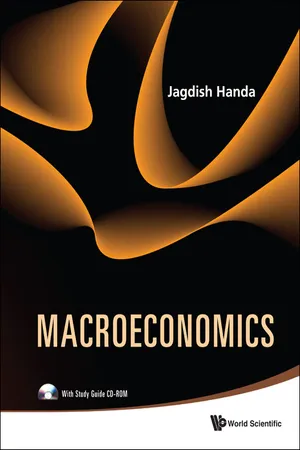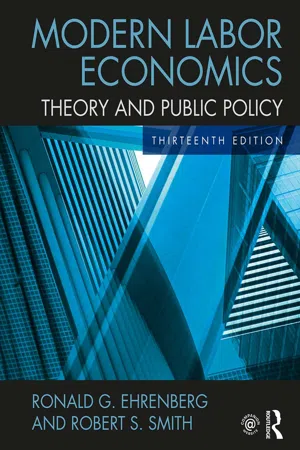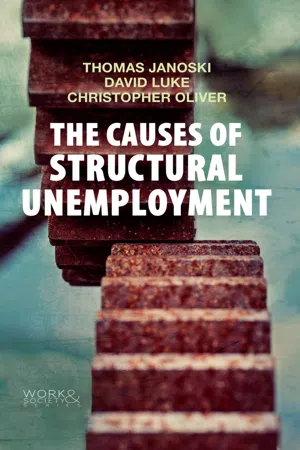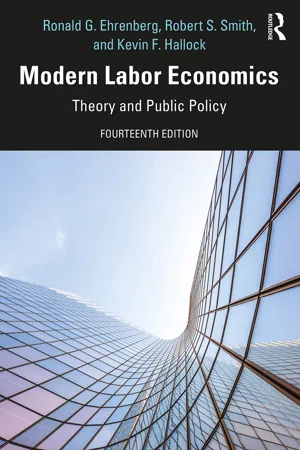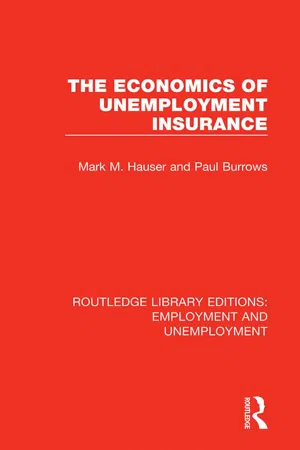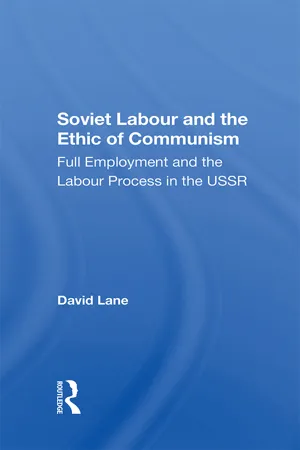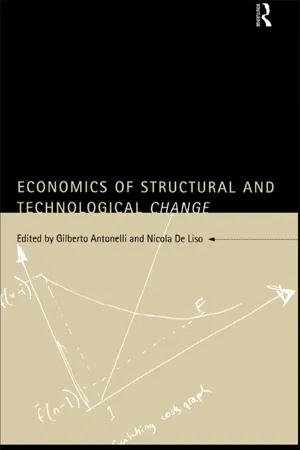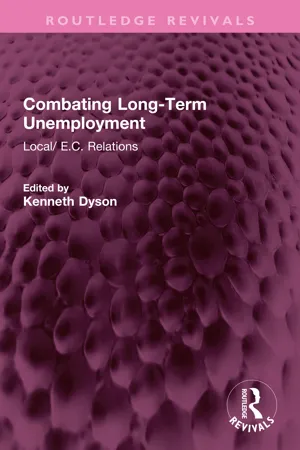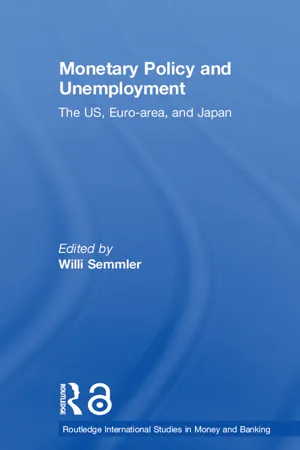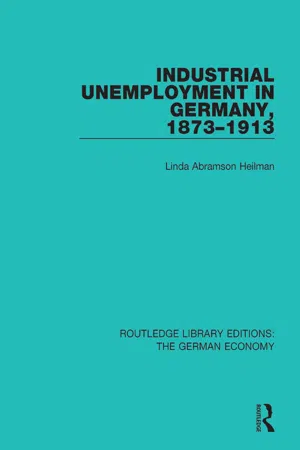Economics
Structural Unemployment
Structural unemployment refers to the mismatch between the skills and locations of available workers and the requirements and locations of available jobs. It is caused by changes in technology, shifts in consumer demand, or changes in the structure of the economy. This type of unemployment can be long-lasting and requires retraining or relocation of workers to address.
Written by Perlego with AI-assistance
Related key terms
11 Key excerpts on "Structural Unemployment"
- eBook - ePub
Macroeconomics
(With Study Guide CD-ROM)
- Jagdish Handa(Author)
- 2010(Publication Date)
- WSPC(Publisher)
matched ): those workers who are in the labor force and the labor supply but for whom the economy does not have enough jobs. Such workers have the appropriate characteristics for jobs for the current nature of the economy and do seek jobs at the current (or even lower) wage, but cannot get jobs because firms do not have enough jobs to offer. The usual reason for the inadequacy of jobs is deficiency of aggregate demand in the economy. Involuntary unemployment is in addition to frictional and Structural Unemployment. Note that it is zero if labor demand equals labor supply at the current wage – i.e., the labor market clears.Macroeconomics focuses on only the last three components of unemployment and defines the level of unemployment U as:U = U structural + U frictional + U invNote that voluntary unemployment is excluded from this definition of unemployment.The rate of unemployment (u ) is defined as the level of unemployment (U ) divided by the labor force (L ). That is, u = U/L. u is often expressed as a percentage of the labor force.In practice, Structural Unemployment is long term, since it is often related to skills no longer consistent with the evolving technology or shifts in the location of jobs. For an individual unemployed worker, it could last many years, even the rest of his life. Frictional unemployment is short term, since it is related to the time taken to find a job, when there are sufficient job vacancies to absorb the workers currently unemployed. It usually lasts a few months. The duration of involuntary unemployment depends on whether it is due to a high real wage or a demand deficiency. The latter is related to the duration of recessions, which normally last about two years.The diagrammatic depiction of the components of unemploymentThe difference between the labor force and the labor supply is Structural Unemployment. At the equilibrium wage rate w* 0 in Figure 10.1b , Structural Unemployment is shown by (L0 – nf - eBook - ePub
Modern Labor Economics
Theory and Public Policy
- Ronald G. Ehrenberg, Robert S. Smith(Authors)
- 2017(Publication Date)
- Routledge(Publisher)
and if costs of occupational or geographic mobility were low, market adjustments would quickly eliminate this type of unemployment. In practice, however, these conditions may fail to hold, and Structural Unemployment may result.Occupational and Regional Unemployment Rate Differences
A two-sector labor market model, represented by Figure 14.5 , can be used to illustrate how Structural Unemployment can arise. For the moment, we shall assume the sectors refer to markets for occupational classes of workers; later, we shall assume that they are two geographically separate labor markets.Occupational Imbalances Suppose that market A is the market for production workers in the automobile industry and market B is the market for skilled computer specialists, and suppose that initially both markets are in equilibrium. Given the demand and supply curves in both markets, (D 0 A , S 0 A ) and (D 0 B , S 0 B ), the equilibrium wage/employment combinations in the two sectors will be (W 0 A , E 0 A ) and (W 0 B , E 0 B ), respectively. Because of differences in training costs and nonpecuniary conditions of employment, the wages need not be equal in the two sectors.Figure 14.5 Structural Unemployment Due to Inflexible Wages and Costs of AdjustmentNow, suppose that the demand for automobile workers falls to D 1 A as a result of foreign import competition, while the demand for computer specialists rises to D 1 B as a result of the increased use of computers. If real wages are inflexible downward in market A because of union contract provisions, social norms, or government legislation, employment of automobile workers will fall to E 1 A . Employment and wages of computer specialists will rise to E 1 B and W 1 B , respectively. Unemployment of E 0 A – E 1 A - eBook - ePub
The Causes of Structural Unemployment
Four Factors that Keep People from the Jobs they Deserve
- Thomas Janoski, David Luke, Christopher Oliver(Authors)
- 2014(Publication Date)
- Polity(Publisher)
6 Fixing Structural UnemploymentRight now, countries like Germany focus on graduating their high school students with the equivalent of a technical degree from one of our community colleges. So those German kids, they're ready for a job when they graduate high school. They've been trained for the jobs that are there … We need to give every American student opportunities like this.Barack Obama (2013)These four causes of Structural Unemployment – mismatches, offshoring, new technologies, and financialization – harm graduating students and employees with more experience in the labor market. Fred Block indicates that we need not only an economic sociology of “economic dysfunction” but also one of “financial reconstruction” (2010:384). Not only does the “chopped-up and incoherent American system of human capital development” need change (Osterman, 2011a:502, 2011b), but it needs to be done on a large scale in “thinking in terms of millions” of people (Mourshed et al., 2012:11). The approach we take here will be mainly focused on reconstructing labor markets. So we will look at a wide variety of government policies and institutions that help counteract these employment difficulties before and after unemployment becomes a problem. Governments vary in how they try to reduce unemployment through active labor market policies and regulation of investment and trade. Our approach will be to provide more targeted programs for job training, job creation, job placement, and encouraging investment.Situating Workers in Labor Markets Undergoing Volatile Structural Changes
Individual employment strategies in AICs are becoming complex. We use a canoeing metaphor to delineate three types of labor markets: (1) the upstream model, with high-paid jobs with high benefits in industries that are constantly producing high-value-added products, where workers can expect employment security and promotions; (2) the downstream model, where wages and benefits are low, especially since the company competes on the basis of low price and of necessity low cost; and (3) the somewhat newer white-water model, based on highly skilled workers being paid well but with little expectation of job security.1 - eBook - ePub
Modern Labor Economics
Theory and Public Policy
- Ronald Ehrenberg, Robert Smith, Kevin Hallock(Authors)
- 2021(Publication Date)
- Routledge(Publisher)
A workers would be created in the short run.If automobile employees could costlessly become computer specialists, these unemployed workers would quickly move to market B, where we assume wages are flexible, and eventually, unemployment in sector A would be eliminated.24 Structural Unemployment arises, however, when costs of adjustment are sufficiently high to slow or even prevent such movements. The cost to displaced individuals, many in their 50s and 60s, may prove to be prohibitively expensive, given the limited time in the labor market that they have to collect returns. Moreover, borrowing funds to finance the necessary job training might be difficult for them.25 The economic and social costs of prolonged unemployment can be significant and not confined to older workers, as seen in Example 14.2 .EXAMPLE 14.2 Structural Unemployment as a Threat to Social Well-BeingOne source of Structural Unemployment in recent years has been the loss of jobs in manufacturing industries owing to technological change and foreign import competition. The loss of job opportunities in manufacturing was felt particularly among less-educated men, many of whom were not well prepared to train for higher-skilled occupations. Those who lost manufacturing jobs (which were relative well paying) were therefore faced with either nonemployment or jobs with lower pay, both of which reduced their economic security and their social stature.Joblessness has devastating social consequences. One study of areas in the United States that lost manufacturing jobs owing to import competition from 1990 to 2014 found that among the young men studied was a marked increase in idleness (i.e., they were neither working nor in school or in educational programs). Marriage rates dropped as young men became less economically secure, and there was an increase in births out of wedlock and the fraction of children being raised in poverty. Drug and alcohol abuse among young men rose, and associated with such abuse was an increase in their mortality rates. - eBook - ePub
- Mark M. Hauser, Paul Burrows(Authors)
- 2018(Publication Date)
- Routledge(Publisher)
A further form of unemployment is commonly referred to as frictional unemployment. This kind of unemployment accompanies technological progress, the reorganisation of production, and lasting shifts in the pattern of demand. Workers in particular jobs and with particular skills lose their occupation and must seek alternative employment. In a dynamic and developing economy there is need for constant change of this kind, which means that the labour force has to adapt itself to new conditions more or less continually. Thus there is a certain level of frictional unemployment at all times, though not necessarily always in the same sectors or in the same geographical areas of the economy.The problems connected with frictional unemployment are different from those connected with cyclical and seasonal unemployment. They occur even where these latter forms of unemployment are at a minimum and even where the demand for labour exceeds the supply. In recent years interest has centred on the relatively high level of frictional unemployment in particular geographical areas and also on the severe impact this unemployment can have on particular sections of the labour force. In its more severe, rather long-term form, frictional unemployment is often referred to as Structural Unemployment.1Chart 2 serves to illustrate the foregoing classification in the case of the British unemployment situation since the war. It shows the development of monthly absolute unemployment totals in the United Kingdom since 1945. Firstly, it can be seen that Chart 2 displays a rising trend in unemployment. This is hardly surprising, since the figures plotted in Chart 2 are absolute unemployment figures and the labour force was rising during the period under observation. So far as the weight of unemployment is concerned, the unemployment rate plotted in Chart 1 is more representative. It shows no clearly rising trend. Secondly the figures plotted in Chart 2 reveal a distinct seasonal pattern in the development of unemployment, with relatively high levels in the winter months and relatively low levels in the summer months of each year. Thirdly Chart 2 also shows the presence of a definite pattern of cyclical fluctuations in the development of unemployment since the end of the second world war. A moving average of quarterly unemployment totals brings out these cyclical fluctuations more clearly. Total unemployment reached peaks in 1952, 1958-59, 1963 and 1967, and troughs in 1955-56, 1961 and 1966. As can be observed from Chart 1 these cyclical fluctuations were in no way as severe as the ones which the British economy experienced between the two world wars. They reflect the ‘minor’ cycle of unemployment mentioned earlier in the text. Fourthly Chart 2 also reveals the presence of certain ‘erratic’ changes in the level of unemployment, the most distinctive of these changes being no doubt the one which can be observed in February 1947. In a study concerned primarily with the ‘systematic’ aspects of unemployment and its problems, these erratic fluctuations are of very small interest, since they display no regular pattern pointing in any way to systematic causes or significant characteristics. Finally, Chart 2 also suggests the presence of a certain amount of frictional unemployment in the British economy. Perhaps the best indication of this is found in the periods when the cyclical and seasonal variations in unemployment reached temporary minima. This was the case in the Summers 1951, 1955, 1961 and 1966. In these periods the average unemployment rate was extremely low (below 2%), and the number of unfilled vacancies at the national level exceeded the number of unemployed workers, which may be taken as a sign that in a general sense the demand for labour in the British economy exceeded the supply and that in the Beveridge sense of the word the economy was operating at, or near, ‘full employment levels’.1 And yet, as Chart 2 - eBook - ePub
Soviet Labour And The Ethic Of Communism
Full Employment And The Labour Process In The Ussr
- David Lane(Author)
- 2019(Publication Date)
- Routledge(Publisher)
4 Types of Involuntary UnemploymentWhile mass Structural Unemployment is not a characteristic of the USSR, one must consider the presence of other forms of unemployment and underemployment, the most important types of which are 'structural', 'seasonal' and 'frictional'. Structural Unemployment is an absence of jobs in a particular labour market. This usually occurs on a regional basis. Population grows in a given area at a faster rate than the supply of jobs. In addition, certain districts might be predominantly concerned with a particular industry having a relatively narrow and specialized pattern of skills: for instance, the mining industry recruits few women workers, in textiles men are a minority and agriculture (at least in the USSR) has a preponderance of unskilled manual workers. 'Seasonal' unemployment is linked to the cyclical nature of production or of demand. In the Soviet Union, due to the inclement winter weather, this is particularly the case with agriculture, fishing, open-cast mining and building. 'Frictional' unemployment occurs when workers are idle between jobs or statuses. School-leavers or demobilized military may not wish, or may be unable, to find suitable work immediately. If workers are hierarchically or geographically mobile there may be periods of idleness between the time that workers leave one job and take up another.Frictional Unemployment
In any modern economy, however perfectly organized, there are likely to be periods of'friction' when school-leavers come onto the market or when employees voluntarily change jobs. Instantaneous individual adjustments which would be necessary to equilibriate supply of (and demand for) labour even in a perfectly free market are impossible to achieve: in any labour market there are always some jobs vacant and some people seeking work. This is illustrated in Figure 4.1 . At wage W, ONi is demanded, but only ON is employed. The frictional level of unemployment is N-Ni.1 - eBook - ePub
- Cristiano Antonelli, Nicola De Liso(Authors)
- 2002(Publication Date)
- Routledge(Publisher)
The various models examined, developing either partial equilibrium analysis or general equilibrium analysis, seem to share the vision according to which economic growth, itself induced by technical progress, does not necessarily guarantee the reabsorption of the labour force displaced by the adoption of new technologies. Technological unemployment, in fact, can emerge either because of insufficient growth of aggregate demand compared with potential productive capacity growth or because of changes in the sectorial composition of demand for goods and labour with respect to the existing productive capacity structure. In both cases, automatic market mechanisms do not seem to be strong enough to guarantee a growth equilibrium path, implying therefore a macroeconomic disequilibrium and/or a sectoral disequilibrium.2 TECHNOLOGICAL UNEMPLOYMENT VERSUS KEYNESIAN AND Structural Unemployment
Studies of technological change do not appear to have given a sufficiently clear-cut definition of the concept of technological unemployment, compared with other categories of unemployment such as Keynesian unemployment or Structural Unemployment (Standing, 1984). In some cases, in fact, it is associated with unemployment due to scarcity of effective demand, while in other cases its structural nature is emphasized. In the first case, unemployment is explained by an insufficient aggregate demand growth compared with the potential supply of goods allowed by innovations which increase the productivity of labour. In the second case, unemployment is seen as determined, given technical progress, by structural changes in the productive capacity of the economic system; changes which manifest themselves, for example, in a physical capital structure incompatible with the full employment of the available labour force. However, these possibilities are not alternative, for they could occur together. In fact, given the low growth rate of demand and technical progress leading to changes in the composition of the demand and of the production structure, unemployment can emerge with both Keynesian and structural characteristics. The prevailing characteristics will depend on the relative intensity of different compensation effects which determine the reabsorption of the labour force initially unemployed as a consequence of the adoption of labour-saving innovations. If the compensation effects principally operate by stimulating the aggregate demand, technological unemployment will assume mainly structural characteristics when there are relevant changes in the composition of the demand and the supply of goods; on the other hand, if the stimuli to the demand due to technical progress are not strong, and there are compensation mechanisms instead which do not trigger the appearance of structural constraints or which actually lead to the overtaking of these possible constraints, technological unemployment will mainly assume Keynesian characteristics. - eBook - ePub
Combating Long-Term Unemployment
Local/ E.C. Relations
- Kenneth Dyson, Kenneth Dyson(Authors)
- 2023(Publication Date)
- Routledge(Publisher)
Sectoral or occupational restructuring is, of course, an ongoing process and has been evident in Western economies for some time, particularly in regard to the decline in employment in industry and the rise in the numbers at work in the tertiary sector. Throughout all sectors there has been a decline in the demand for unskilled labour. In recent years, however, in the wake of the recession which followed the second oil-price shock of 1979, the process appears to have accelerated. The result has been large-scale redundancies in traditional industries such as clothing, textiles, coal mining, heavy engineering, shipbuilding, etc. This scenario, when viewed in the context of other factors such as the ‘queuing’ phenomenon just referred to, is obviously one which can lead to a serious long-term unemployment problem. In such circumstances redundant workers find it difficult to avail themselves of new job opportunities which are frequently in different locations and require higher educational levels and/or different skills and attitudes. The wide variation across countries, evident from the statistical indicators given in table 2.1, suggests that basic differences in the way labour markets operate can influence the unemployment situation. In this context labour-market flexibility is an issue which inevitably comes to mind. The view is held that lower levels of both unemployment and long-term unemployment are more easily attained in more fluid, less regulated labour markets. Opinions differ, however, as to the significance of this argument. Proponents of the flexibility argument point to the experience in North American labour markets and attribute the low unemployment levels achieved to the more fluid conditions which prevail, characterized by greater mobility and higher flows into and out of both employment and unemployment. This is contrasted with the consistently higher unemployment rates and higher incidence of long-term unemployment in many European countries - eBook - ePub
Introducing a New Economics
Pluralist, Sustainable and Progressive
- Jack Reardon, Maria Alejandra Caporale Madi, Molly Scott Cato(Authors)
- 2017(Publication Date)
- Pluto Press(Publisher)
In solving a problem it is imperative to conceptualise it, discuss the reasons for its existence, engage in dialogue with others to get different points of view, and then develop an effective solution. And, once this is implemented, to regularly monitor the problem: ‘Are we making progress or should we go back to the drawing board?’ In a dynamic economy some unemployment is normal: future expectations are not perfect and there will always be a disconnect between available jobs, information and the supply of workers. And, ironically, the more dynamic an economy, the higher the unemployment, due to structural, frictional and voluntary reasons. Would we want to live in a society with perfect certainty?Table 7.3 lists the reasons and solutions for each type of unemployment. Some unemployment is normal although economists disagree on what normal is. The least serious and least bothersome type of unemployment from a policy perspective is voluntary, since this is mostly due to the volition of the worker. On the other hand, the most serious type is involuntary, signaling that the economy is unable to adequately provision for all of its members, and requires the most concerted public policy effort.Table 7.3 Conceptualisation of Unemployment (Based on Conventional Definitions)Type Reason Solutions Involuntary Lack of aggregate demand. Increase aggregate demand. Frictional Inevitable mismatches. Better information. Voluntary Misaligned expectations; Imperfect information. Better information. Frictional Changing economy. Worker education/training. Cyclical Recessions. Reduce severity of by government policy. Source: Authors.Box 7.3 Unemployment in Neoclassical ModelsAs neoclassical economics developed, it emulated the physics of Isaac Newton and, interestingly, parried the new physics of the twentieth century. If neoclassical economics had followed the path of the new physics – particle physics, the principle of uncertainty, etc. – economics would be very different today, eschewing equilibrium and becoming much more humble and pluralistic. Alas!A key belief of neoclassical economics is that the economy tends towards equilibrium, and that if this is unattained, it is due to systematic interference with the laws of supply and demand, such as a trade union increasing the wage above the market-determined wage, or the imposition of the minimum wage. This belief is based on deductive reasoning –albeit, as it turns out, quite faulty: see Reardon (2006) – rather than empirical evidence. It is assumed as a matter of faith that price adjustments will guarantee full employment, and that worker and firm reactions are based on an automatic and unthinking reaction to market forces. - eBook - ePub
- Willi Semmler(Author)
- 2004(Publication Date)
- Routledge(Publisher)
Part III Structuralist causes of unemployment and monetary policy 8 The structuralist perspective on real exchange rate, share price level, and employment path What room is left for money? Hian Teck Hoon, Edmund Phelps, and Gylfi Zoega The current sluggish performance of the US economy follows one of the most remarkable booms in recorded history. The late 1990s was a period of striking expansion of both output and employment, with the unemployment rate hitting 3.9 percent in 2000; productivity growth was much improved, in part because of higher utilization, though not exceptional. 1 The absence of rising inflation during this period came as a surprise to many since the level of the natural rate of unemployment was commonly estimated to be in the range of 5–6 percent by the mid-1990s. The noninflationary boom, however, reminds one of another episode where nonmonetary forces were strongly at work, namely the nondeflationary slump in Europe and elsewhere in the 1980s and 1990s, which appeared to signal a move to a higher natural rate of unemployment. The modeling of such structural slumps and booms is the task that we have tackled in a series of works in recent years, the book Structural Slumps being a milestone. 2 The theory set out in Structural Slumps is based on intertemporal nonmonetary models of the modern (thus incentive-compatible) kind and provides microeconomic foundations for a moving natural rate of unemployment. Involuntary unemployment occurs, since incentive wages and consequent job rationing are allowed, and this unemployment is structural, not a result of deficient aggregate demand. The determining structure includes tax rates and regulations, the focus of supply-side (SS) theory and includes fluctuations in technical progress, the focus of “real business cycle” (RBC) theory but includes much more - eBook - ePub
- Linda A. Heilman(Author)
- 2017(Publication Date)
- Routledge(Publisher)
DETERMINANTS OF AGGREGATE UNEMPLOYMENT LEVELS Among theoretical explanations of the causes of unemployment, overproduction was the most frequently articulated source of trouble. Between 1873 and 1913 excess supply rather than insufficient demand was considered the primary factor in work shortages by most contemporaries. Only a few nineteenth-century observers recognized that lack of aggregate demand for goods and services also produced periodic diminutions of job opportunities. Reduced rates of economic growth such as Germany experienced in the late 1870’s and early 1890’s might have been alleviated by policies calculated to increase aggregate demand but measures such as tax cuts were not adopted during our period. In addition to explanations of unemployment which attributed the situation to imbalances between the supply and demand of goods and services, there were those who focused more directly on the labor market itself. Structural Unemployment was the result of mismatching between job seekers and job opportunities. Factors such as population distribution, urbanization, labor mobility, expectations about the terms of employment, the location of industries and the educational level of the work force came into play here. A complex of interrelated factors impinged on the job market: Employers’ demand for workers, real-wage rates stipulated by potential employees, the distribution of labor and its mobility. The relationship among these factors at any given point in time went far to determine the extent of mismatching which resulted in Structural Unemployment. This type of unemployment could be remedied by improved dissemination of information in the labor market which was the avowed function of Arbeitsnachweise after 1890. It could also be alleviated by efforts to augment the qualifications of potential employees through additional training or education
Index pages curate the most relevant extracts from our library of academic textbooks. They’ve been created using an in-house natural language model (NLM), each adding context and meaning to key research topics.
